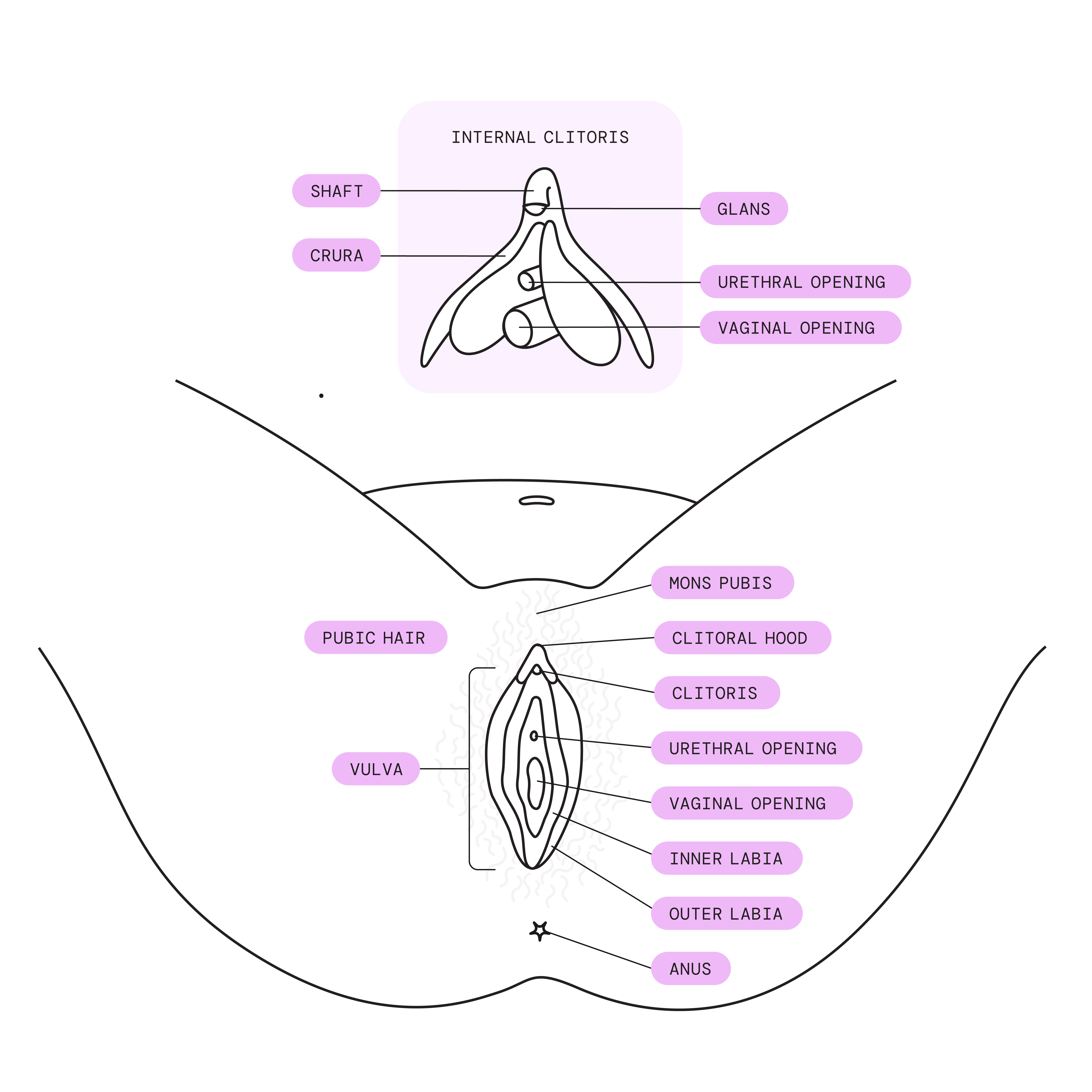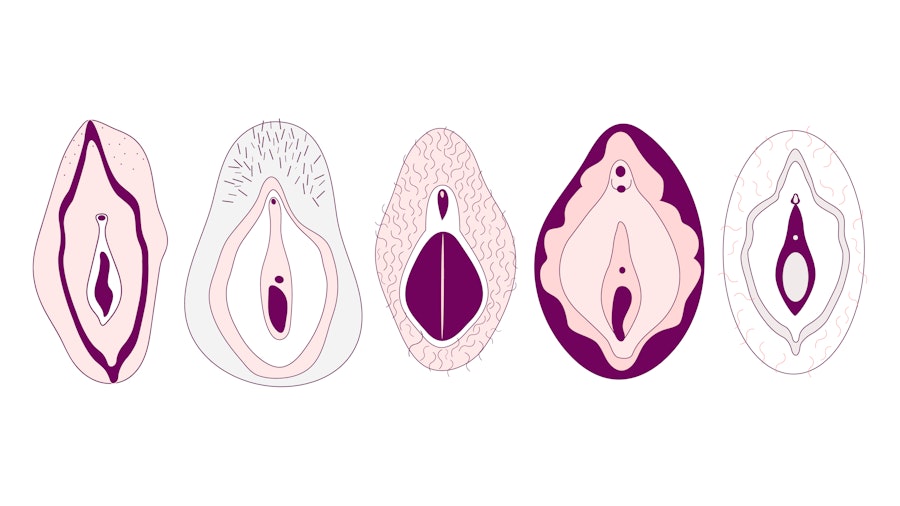Vulva: Diagram, function, location & anatomy
Follows NC° Editorial Policy
At Natural Cycles, our mission is to empower you with the knowledge you need to take charge of your health. At Cycle Matters, we create fact-checked, expert-written content that tackles these topics in a compassionate and accessible way. Read more...
Key takeaways
- The vulva is an important part of the female anatomy and contains several important parts, including the head of the clitoris and the opening to the vaginal canal
- The vulva also serves as a protective barrier for our internal organs and plays an important part in making sure the female reproductive system works as it should
- Despite its importance, the vulva remains a subject of significant misunderstanding and taboo in many cultures
- Ensuring your vulva stays healthy is important for your overall reproductive health. As the gatekeeper to the reproductive and urinary systems, the vulva requires attentive and gentle care
Vagina vs vulva
While the terms "vulva" and "vagina" are sometimes used interchangeably, they refer to distinct anatomical structures. The vagina is a muscular canal that connects the vaginal opening to the cervix and uterus. The vulva, on the other hand, is the external part of the female genitalia, where the labia and clitoris are located.
Labia is the name for the skin folds you can see on the vulva. These serve as a protective covering for the delicate structures within the vulva. Your labia enclose the openings to the urethra and the vagina and are rich in blood vessels and nerve endings. These are unique structures and come in all shapes and sizes.
Located at the top of the vulva is the clitoris, a highly sensitive organ that plays an important role in sexual pleasure.
Vulvas are like snowflakes: no two are alike, and we think it’s important to celebrate this difference.
What is the function of the vulva?
The vulva is a complex and multifunctional part of our anatomy, and it plays a key role in our sexual, reproductive, and urinary health.
The vulva acts as a protective gateway between the body's internal and external environments. It’s important for all sorts of processes, including sexual stimulation, lubrication, and urination.
Here are a few examples of some of the incredible things vulvas do to support our health:
Protection
As mentioned above, the vulva plays an important part in protecting our reproductive organs from external damage. Skin folds serve as a physical barrier, shielding the delicate parts like the vagina and clitoris.
Reproduction
During sexual intercourse, the vulva serves as an entry point to the vagina, allowing sperm to collect before traveling through the cervix toward the uterus and fallopian tubes, where a sperm cell may potentially fertilize an egg cell.
The vulva contains sensitive nerve endings that, when stimulated, can lead to increased blood flow and lubrication of the vaginal canal (also known as getting wet) this is a key sign of female sexual arousal.
Menstruation
The vaginal opening, located on the vulva, is where blood flows from when we get our periods. This menstrual tissue that makes up the uterine lining flows through the cervix, into the vagina, and out of the body via the vulva.
Urination
The vulva also plays an important role when you go to the toilet, by guiding and directing urine flow during urination. During urination, urine flows from the bladder, through the urethra, and out of the body through the urethral opening located on the vulva.
Lubrication
Lubrication is another important function of the vulva. Skene's glands, located on either side of the urethra, are believed to secrete substances that lubricate the opening of the urethra and help to prevent infections.
The Bartholin's glands, located under the skin and close to the vaginal opening, secretes a mucus-like substance into the vagina and nearby area. This fluid acts as a moisturizer that helps to reduce friction during sexual intimacy, an important part of female pleasure!

Where is your vulva located?
The vulva is located on the outside of your body between your legs. You can get a closer look at this area using a handheld mirror. The areas around your vulva are:
Pubic mound
The pubic mound is located directly in front of the pubic bones. This mound of soft tissue is largely covered in pubic hair and has a layer of fat in place to cushion and protect this area.
Fun fact: the pubic mound also contains glands that are responsible for secreting pheromones that stimulate sexual desire.
Labia majora
The labia majora are the outermost folds of skin on the vulva. They are located on either side of the vaginal opening, running from the mons pubis (the fatty tissue over the pubic bone) to the perineum (the area between the vagina and anus).
Labia minora
The labia minora are the smaller, innermost folds of skin that lie within the larger labia majora. They surround the vestibule and help to protect the more sensitive internal structures of the vulva, such as the clitoris and vaginal opening, from friction and potential irritation.
Vulva vestibule
The vulvar vestibule is the area between the labia minora and begins just below the clitoris and extends down to the lower part of the vulva, where the labia minora meet.
The vulvar vestibule contains the openings to both the vagina and the urethra. The edges of the labia minora form the borders of the vestibule.
Clitoris
The clitoris is located at the top of the vulva, where the inner labia meet. The part of the clitoris you can see when you look at the vulva is only a fraction of the total clitoris.
The clitoris is highly sensitive and contains thousands of nerve endings, similar to the penis when aroused due to increased blood flow.
Urethra
The urethra is located within the vulva vestibule. This is the opening where you pee from, and is a smaller opening than the vagina.
These two openings are separate and have separate functions too. The urethra allows for the passage of urine, while the vaginal opening plays a role in sexual intercourse and menstrual flow.
Vaginal opening
The vaginal opening is the external part of the vagina. This is the entrance to the vaginal canal, which extends from the vulva to the cervix of the uterus.
The vaginal passage has a whole bunch of purposes, including excreting menstrual blood when you’re on your period and acting as the birth canal through which a baby travels during childbirth.
What are some tips for caring for my vulva?
Keeping your vulva in good health is crucial for your reproductive well-being. Here are a few tips to help you care for your vulva.
Ensure a clean environment: Gently wash the vulva with warm water and avoid harsh chemicals or perfumed products, as they can disrupt the natural balance of the vulva.
Did you know your vulva is home to a whole host of species of microbes that are different from the ones that live in your vagina? These small but mighty microbes are an important part of your vulvo-vaginal health, and harsh soaps and chemicals can disrupt things.
Wear breathable underwear: Whenever possible, opt for cotton underwear and loose-fitting clothing. This allows air circulation and helps prevent moisture buildup. Avoid tight-fitting undergarments or synthetic materials that can trap heat and moisture, leading to irritation.
Avoid douching: This practice involves using a douche bulb, shower head, or other device to spray water in order to ‘flush out’ or clean an area. Douching is not necessary and can actually be harmful. It can disrupt the natural microbial balance of the vulva and vagina and increase the risk of infections.
Practice safe sex: Use barrier methods of contraception, such as condoms, to protect against sexually transmitted infections that can affect the vulva.
Maintain good hygiene during menstruation: Change sanitary pads or tampons regularly to prevent bacterial growth. Consider using fragrance-free and hypoallergenic menstrual products to minimize irritation.
Avoid excessive scrubbing or harsh treatments: The vulva is a delicate area, so avoid using harsh scrubbing techniques, strong chemicals, or hair removal methods that can cause irritation.
Five facts about the vulva
The vulva is pretty amazing, right? On top of keeping us protected, helping aid sexual pleasure, and playing an important part in reproduction, there are some pretty cool nuggets of information about the vulva we think you should know, including:
- Your vagina is self-cleaning: Opening on your vulva, the vagina has self-cleaning abilities. A simple daily wash with warm water of the vulva is usually all that's required to keep this delicate area fresh and functioning at its best. You may still want to use a delicate soap in the general vulva area but try to avoid getting any in the vagina itself.
- Your vulva tells a story: The vulva can provide important indications of overall health. Changes in the vulva, such as an itchy vulva or redness, may be a sign of various conditions, including infections, allergies, or hormonal imbalances. It's essential to pay attention to any unusual symptoms and seek medical advice if needed.
- Your vulva holds the key to pleasure: A recent study uncovered that only 18% of women experience orgasm through vaginal penetration alone. Many individuals require clitoral stimulation to reach climax, and where is the clitoris located? That’s right: on the vulva.
- The clitoris is bigger than you think: The tip or head of the clitoris you can see on the vulva is just the size of a pea. However, this is just the tip of the iceberg. The rest of the organ spreads internally and can be as long as 5 inches (12cm)!
- The vagina is not the vulva: One more time for the people in the back: the vagina is not the vulva! While this difference between vaginas and vulvas may seem small, we think it’s an important one. A better understanding of our bodies can empower us. With increased knowledge of our bodies, we can recognize when things aren’t working as they should and seek help when we need to, plus, knowing our anatomy better can help us lead better sex lives. What’s not to love?
We recommend speaking to a healthcare professional if you have questions or concerns regarding your own reproductive health, but there are small things we can all do every day that also help broaden our horizons. Learning more about your body helps debunk societal misconceptions and prevents the spread of myths.
We hope you’ve learned something new about the vulva! At Natural Cycles, we’re committed to closing the knowledge gap where the wider contraceptive landscape is concerned. Not only is Natural Cycles the first and only FDA Cleared digital birth control, but it’s also personalized to you. With in-app messages, reminders, and notifications, you can keep track of where you are in your cycle and learn unique insights about your body, all while preventing pregnancy 100% hormone-free.
Did you enjoy reading this article?
